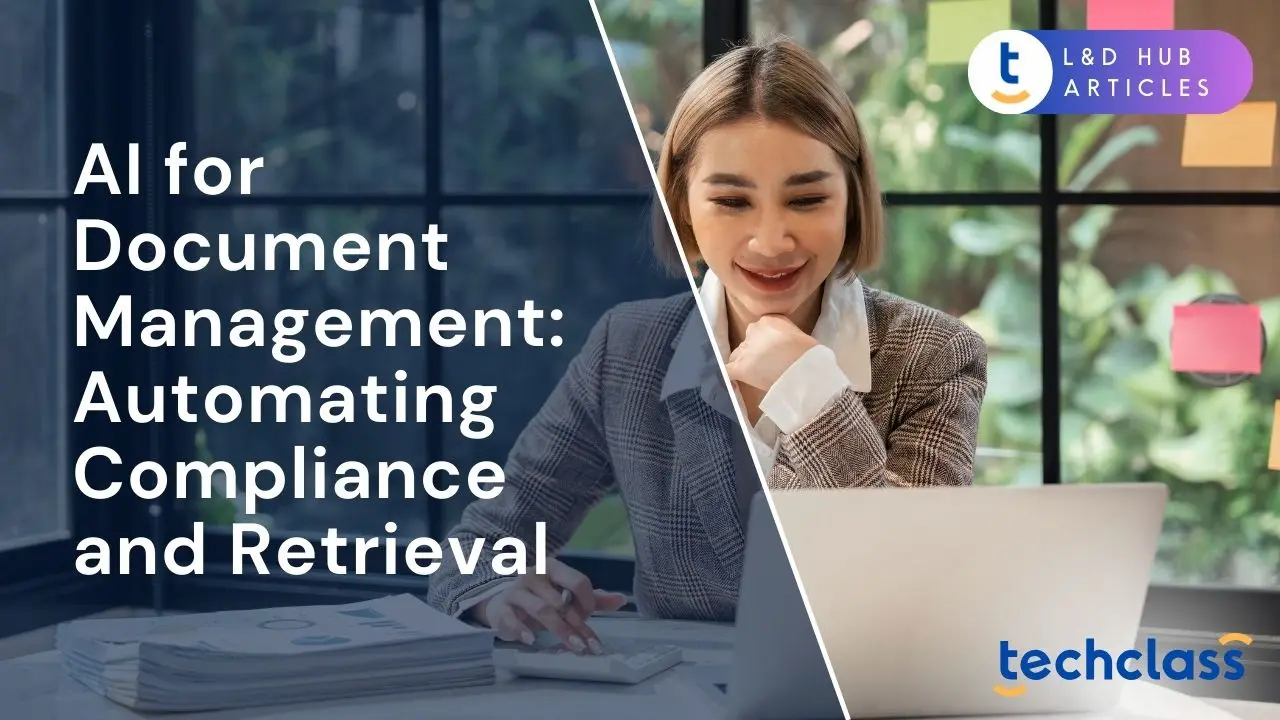
Modern businesses are drowning in documents, contracts, employee records, emails, reports, and more. Managing this deluge of information is challenging, especially when it comes to regulatory compliance and quickly retrieving the right document at the right time. Many organizations still rely on manual processes or disparate systems, leading to lost time and heightened risk. In fact, 83% of employees admit they routinely recreate files that already exist simply because they cannot find them in their system. Not only does this duplicate effort hurt productivity, it can also result in compliance slip-ups when critical records aren’t accessible for audits or legal needs.
Amid these challenges, artificial intelligence (AI) is emerging as a transformative solution. AI-driven document management promises to automate compliance tasks and make information retrieval almost effortless. By intelligently organizing data and understanding content, AI helps businesses maintain order, avoid costly mistakes, and respond faster in today’s information-driven environment. Before exploring how AI achieves this, let’s outline the key topics we’ll cover in this guide.
Every day, organizations generate and store an immense volume of documents. Yet finding a specific file or ensuring a record meets regulatory requirements can be like finding a needle in a haystack. Traditional document management often involves siloed storage (shared drives, email attachments, filing cabinets) and human-dependent processes that are prone to error. Common challenges include:
Traditional approaches are struggling to keep up. Broken document workflows have tangible impacts, reduced productivity, frustrated employees, and increased compliance risk. This is where AI-powered document management steps in as a game-changer, addressing these pain points by bringing automation, intelligence, and speed.
To successfully implement these systems, organizations often invest in AI training programs to ensure employees understand and can leverage intelligent document management tools effectively. AI technologies are uniquely suited to tame the complexity of modern document management. Rather than handling files in a rigid, manual way, an AI-driven system “understands” documents and can adapt to content in clever ways. Here’s an overview of how AI brings transformation:
In short, AI turns document management from a static archive into a dynamic, smart system. It not only stores and finds documents more effectively, but also actively manages compliance and learns from the data. Next, we will delve deeper into two critical areas that AI revolutionizes: compliance and retrieval.
Staying compliant with laws and regulations is non-negotiable for businesses, especially in fields like finance, healthcare, or human resources where regulations are strict. AI offers powerful tools to automate compliance tasks and reduce the chance of human oversight or error. Here’s how AI enhances document compliance and governance:
1. Intelligent Compliance Monitoring: AI systems can continuously monitor all documents and data for compliance issues. They identify sensitive information (such as personal identifiers, financial account numbers, health information) and ensure it’s handled properly. For example, if a document contains a Social Security Number, AI can flag it for encryption or restricted access per privacy regulations. In industries like finance or healthcare, where privacy laws (GDPR, HIPAA, etc.) apply, this automated scanning is invaluable. It’s like having a compliance officer review every document uploaded, in real time.
2. Policy Enforcement and Audits: A major challenge is enforcing internal document policies (retention schedules, approval requirements, access controls). AI-driven document management can encode these rules. As noted earlier, AI can automatically apply data retention and deletion policies, ensuring records are kept for the required period and then disposed of when no longer needed. This mitigates the risk of holding onto data longer than allowed (a common compliance violation). Moreover, AI keeps detailed audit trails, recording who accessed or modified a document and when. This immutable audit trail is a lifesaver during formal audits or investigations, providing clear evidence that proper controls are in place. In one legal case management scenario, an AI system provided blockchain-verified document tracking and immutable audit logs, giving the firm confidence that every access to a file was recorded for compliance purposes.
3. Detecting Anomalies and Risks: Compliance breaches often hide in subtle anomalies, an unusual download pattern, an employee emailing a confidential file to a personal address, or a form filed incorrectly. AI excels at anomaly detection. It learns what “normal” document usage looks like in your organization and can alert compliance teams to irregularities immediately. For instance, if a normally static archive of records suddenly sees a spike in access or changes, AI will notice. Early detection means issues can be addressed before they escalate into full-blown violations, thereby avoiding hefty fines or legal troubles. This proactive stance is far superior to discovering problems only during an annual audit.
4. Adapting to Regulatory Changes: Regulations are moving targets, new laws get introduced (for example, new data privacy requirements) and existing ones evolve. AI-driven compliance tools can be updated with new rules and then scan your entire document repository to find any gaps. If a new rule mandates that certain contracts must include a specific clause, an AI system can quickly search through all contracts to identify any missing that clause. This beats manually reviewing hundreds of documents. In fact, 93% of compliance teams agree that advanced technology like AI makes it easier to meet regulatory requirements, underscoring how crucial these tools have become for modern compliance management.
5. Case in Point, HR Records Compliance: Consider Human Resources departments, which handle sensitive employee records and numerous regulations (labor laws, retention requirements, privacy rules). Traditionally, HR may struggle with keeping every employee file up-to-date and compliant. It’s telling that only 28% of businesses have adopted digital document solutions for HR so far, yet those who did report improved record retention and compliance. AI can dramatically improve this: for instance, an AI-powered HR document system can automatically ensure each employee’s file has all required forms, flag if a certification is expired, or even generate compliance reports on demand. Such a system securely manages records and can answer an auditor’s query in minutes by pulling up exactly the needed documents, rather than HR staff spending days combing through cabinets. By automating these checks, HR teams reduce the risk of penalties and free up time to focus on strategic work rather than paperwork.
In all these ways, AI acts as a continuous compliance guardian. It minimizes the chance of something slipping through unnoticed, maintains rigorous standards around how documents are handled, and instantly surfaces the information needed to demonstrate compliance. Next, we’ll see how AI similarly transforms the retrieval of information, making lost documents and fruitless searches a thing of the past.
Finding the right document when you need it has historically been a pain point, employees waste not only time but also experience frustration that can slow business momentum. AI-driven retrieval changes the game by making search smarter, faster, and more intuitive:
1. Natural Language Search: One of the most visible benefits of AI in retrieval is the ability to search documents using natural, everyday language. Instead of trying to recall exact filenames or keywords, users can ask the system questions or describe what they need. Modern AI document management systems use NLP algorithms to understand user queries and extract relevant information from both structured and unstructured data. For example, you could type “Find the contract we signed with ACME Corp last July” and the AI search would interpret this, look at document dates, parties, content, and bring back the ACME contract, even if “ACME” or “July” aren’t explicitly in the file name. This is a huge leap in usability, allowing anyone (not just IT specialists) to quickly retrieve information.
2. Contextual and Semantic Search: Beyond keywords, AI-powered search understands context and intent. It learns relationships between terms and documents. If you search for “quarterly earnings Q3,” the system might also surface related files like spreadsheets or presentations that contain financial data for the third quarter, even if they aren’t labeled obviously, because it knows those documents are contextually related. According to experts, AI search boosts accuracy and relevancy by learning the purpose behind queries, continuously refining results. The search engine effectively gets “smarter” over time, as it observes which results users found useful or which they had to refine. The outcome is more personalized and precise results with each use.
3. Faster Access, Less Wasted Time: The productivity impact of intelligent retrieval is significant. When employees can find what they need in seconds, they reclaim hours that would otherwise be spent hunting through folders or emailing colleagues for files. Recall that earlier stat, 83% of staff recreate files they can’t locate, a problem that nearly disappears with effective AI search. Moreover, consider a real-world example: a law firm implemented an AI-driven document retrieval platform and saw dramatic improvements. Attorneys who used to spend 2-3 hours daily searching for case files found information almost instantly after AI was introduced. Overall, the firm achieved a 90% reduction in document processing time, and each attorney saved about three hours per day that could be reallocated to billable work. This kind of time savings not only improves efficiency but also has direct financial benefits (more time for productive tasks and fewer billable hours lost to admin work).
4. Advanced Features: Recommendations and Q&A: AI retrieval can go beyond just returning a list of documents. Some systems provide document recommendations, for instance, if you retrieve a policy document, the system might suggest related documents like guidelines or training material that others found useful in context. This helps surface knowledge that users might not even know exists in the organization. Additionally, with the rise of Generative AI, we are seeing features like document question-answering: the AI will read through relevant documents and provide an answer or summary. For example, instead of opening a lengthy policy PDF to find an answer, you could ask, “What is our company’s parental leave duration?” and the AI would generate a concise answer drawn from the policy text. This turns document retrieval into a more interactive knowledge tool, where users get answers, not just documents. Many companies are exploring such AI assistants to turn their document repositories into a dynamic knowledge base rather than a static archive.
5. Reliability and Reduced Lost Documents: Another byproduct of AI-driven retrieval is that documents are far less likely to be “lost” or overlooked. Since the AI indexes everything (often including scanned images and emails that humans might forget about), even obscure documents can be found. The days of important files disappearing into inboxes or misnamed folders wane. This reliability is crucial for compliance and legal readiness: if an regulator asks for a seven-year-old record, AI search can dig it up quickly, ensuring the company can respond within required timeframes. It’s also a morale boost, employees trust the system to yield results, so they don’t feel the need to hoard local copies “just in case,” which in turn improves version control and consistency.
In summary, AI makes information on-demand a reality. By understanding language and context, learning from usage, and even delivering answers directly, AI retrieval tools let professionals spend less time searching and more time using information. This improved accessibility of knowledge can accelerate decision-making and innovation across the enterprise.
AI for document management is not a theoretical concept, many organizations across various industries are already reaping the benefits. Let’s look at some real-world applications and outcomes that illustrate the impact:
These examples make it clear that AI-driven document management is not a one-size-fits-all proposition, but a flexible toolkit that can be applied to many domains. Whether it’s reducing a legal team’s research time, ensuring HR files are always compliance-ready, or speeding up financial reporting, the core outcomes are similar, saved time, stronger compliance, and empowered employees who can focus on high-value tasks instead of chasing paperwork.
In today’s information-heavy business environment, leveraging AI for document management is quickly shifting from a cutting-edge option to a practical necessity. The combination of ever-growing data volumes and an unforgiving regulatory landscape means that doing nothing is costly, in both dollars and risks. AI offers a path forward by automating the drudgery and complexity out of compliance and retrieval. It acts as a tireless assistant: organizing files, watching for compliance issues, and fetching information on demand.
For leaders and professionals (from HR managers to enterprise executives), the value of AI in this arena lies in peace of mind and productivity. Imagine audits where you aren’t scrambling for records, or team meetings where anyone can pull up the latest data in seconds. That’s what AI-enabled document systems are delivering. And importantly, this isn’t about replacing humans, it’s about augmenting teams so they can focus on judgment calls and creative problem-solving while the AI handles routine classification, monitoring, and searching tasks.
Adopting AI for document management does require thoughtful implementation. Businesses should ensure data security and privacy when choosing AI tools, for instance, verifying that an AI platform complies with relevant regulations and has robust access controls. Training and change management are also key; staff should be comfortable with the new systems and trust the AI’s recommendations. Starting with a pilot project (say, automating one department’s documents) can help demonstrate quick wins and build confidence across the organization.
The bottom line is that AI transforms documents from a liability into a strategic asset. Instead of being bogged down by files and rules, companies become free to use information proactively, spotting trends, serving customers faster, and innovating with insights drawn from their data. As AI technologies continue to mature, we can expect even more seamless integration into daily workflows, perhaps with voice-activated document retrieval or smarter predictive compliance alerts.
For now, organizations that embrace AI in document management position themselves ahead of the curve. They enjoy smoother compliance, faster retrieval, and a more empowered workforce. In an era where information is power, harnessing AI to manage and leverage that information is one of the smartest moves a business can make to ensure efficiency, compliance, and success.
AI continuously scans documents for sensitive information, enforces retention policies, and maintains detailed audit trails. It can detect anomalies, adapt to new regulations, and ensure all records meet legal and policy requirements, reducing human error and compliance risks.
Yes. AI uses Natural Language Processing and contextual search to interpret user queries in plain language, retrieving relevant documents even if keywords don’t match exactly. This drastically reduces search time and eliminates the need to recreate lost files.
Industries like legal, HR, finance, and healthcare use AI to automate document classification, ensure compliance, and speed up retrieval. Examples include AI systems that prepare audit-ready HR files, verify financial document integrity, and securely manage patient records.
AI can process a wide variety of file types, including PDFs, images, emails, and scanned paper records. Using OCR and machine learning, it extracts structured data from unstructured sources and applies consistent metadata for better organization and retrieval.
Yes, reputable AI document management systems include robust access controls, encryption, and detailed activity logs. They help organizations comply with regulations like GDPR or HIPAA while protecting sensitive information from unauthorized access.


